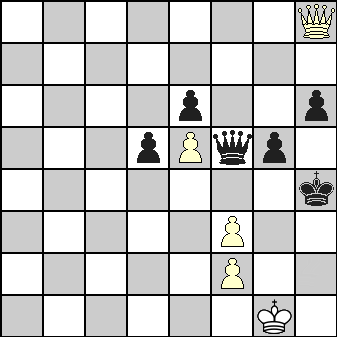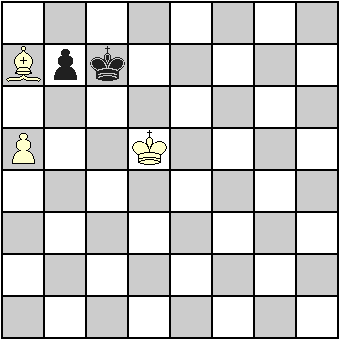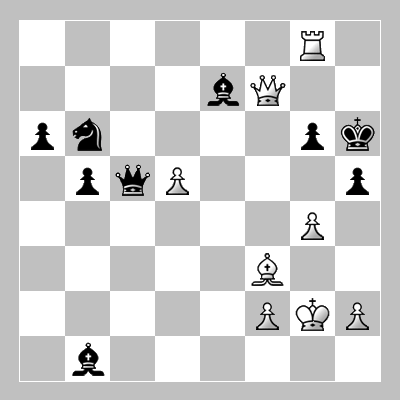In an earlier article, I pointed out that in the middle games, you cannot possibly visualize all the positions that can emanate from your next 4-5 moves without having a computer-like memory. Most likely, you will decide on the next move based on your reading of the overall position.
But in the endgame, with few pieces standing on the board, it is possible to make a deeper analysis and this often makes the difference between a win and a draw or loss. But it is easier said than done, as even experienced players sometimes fail to see the right moves available as it is, or fail to identify a bad move from the opponent that could be exploited.
The following two examples will make the point clear and establish the importance of studying endgame tactics. You should also see the 4 endgame tactics given before as some of those themes occur in the following examples also.

In the position shown, Black seems to have the advantage because of an extra pawn plus the poor pawn structure of White due to doubled pawns. In this position, Black played h5 which was a bad move as it deprives black king of one of the two escape squares at h3 and h5. But White could not utilize this opportunity and ended up a loser.
How could White turn the table after Black’s move? Here is the possible sequence:
| 1. | … | h5 | ||
| 2. | Qf6 | Qh3 |
You can see that Black cannot afford to exchange Queens on f5 or f6 square as after that, White’s KP cannot be stopped from ‘queening’.
Even retreat to f4 square does not help as White’s Queen will capture Black’s KP, thus freeing his own KP to advance. Advancing NP by Black to create a counterplay also fails as it allows check by White Queen along d8-h4 diagonal forcing exchange of Queens. In the race for ‘queening’, White KP gets it one move before Black’s QP does and White gets the chance to finish off the game before Black’s promoted Queen can move!
| 3. | Qf7 | d4 | ||
| 4. | Qf8 | d3 |
White is maneuvering to force Black to advance the pawn so that he can strike at the right moment.
| 5. | Qb4+ | g4 | ||
| 6. | Qe7# |

In this position, White has a Bishop and Pawn against Black’s single Pawn. But the Bishop has no control on white squares, so it cannot capture Black’s pawn. So long as black King is hovering around the pawn, White’s King cannot get near the black pawn to capture it. White’s pawn cannot advance past Black’s pawn without getting captured and a King and Bishop are inadequate to deliver a mating attack. Even if White Pawn could proceed to “queening” square (a8), the bishop will not be able to support it. On the other hand, Black also cannot advance the Pawn without handing over the game to White. It looks like an impasse, doesn’t it? So your conclusion will be the same as that of the actual players who agreed to a draw. But is a draw inevitable?
You know what strategy Black has to follow. So, to prevail upon Black, your strategy should be to push the Black King away from the 3×3 square (a8-c8-a6-c6) through Bishop checks. At the same time, your White King should try to gain the opposition to prevent Black King from reentering this square. Black in turn will try to use opposition to block White King’s approach or to take refuge at a8 square. So White has to follow some precise steps as follows.
| 1. | Kd4 | Kc6 | If White K moves to c5 or c4, Black delivers check by advancing pawn and White has to capture it. Black then proceeds to a8 square to create a stalemate situation. Black in turn cannot advance his pawn or move K to d-file without giving the initiative to White |
|
| 2. | Bb6 | Kd6 | If Black goes to b5, White King can occupy d5 preventing Black King from going back to save his pawn | |
| 3. | Kc4 | Kc6 | ||
| 4. | Kb4 | Kd6 | ||
| 5. | Kb5 | Kd7 | ||
| 6. | Kc5 | Kc8 | Other moves of Black King will allow White Bc7 and then Kb6 to keep Black King at bay | |
| 7. | Ba7 | Kc7 | ||
| 8. | Kb5 | Kd7 | ||
| 9. | Bb8 | Kc8 | ||
| 10. | Bh2 | Kd7 (or Kd8) |
||
| 11. | Kb6 | and White wins as he will soon capture Black’s pawn and promote his pawn unhindered |



